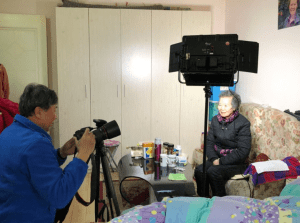Smartphone and the ‘sense of ritual’ in daily life — by Xinyuan Wang
By Xin Yuan Wang, on 31 May 2019
“I have not been photographed by a proper camera for ages! It feels so special…nowadays most people only take photos by mobile phone.”
79-year-old Mengyun claimed with a big smile after posing for the portrait photographing. Mengyun is one of my neighbors who joined an oral historical project which I co-operate with the local residential compound in Shanghai. As part of the project, I invited Mr. Shou, a professional photographer, to take portrait photos for a few families.
Mr. Shou is an experienced photographer who has done a lot of work especially among the elderly. He sees this none-profit photography project as something he has to do with great respect:
“Many people passed away without a proper photograph. Every person deserves a proper portrait photo in his or her life. What I want to do is not just take photos, but keep the great memory of the person. I take it with great respect and people can also feel the sense of ritual. Life needs sense of ritual, don’t you think so?”
Mr. Shou always mentioned the phrase ‘sense of ritual’ (yi shi gan) to highlight the significance of the photography session. After seeing how the three-generational family finally arranged a photo slot which can suit every member’s schedule after four-day back-and-forth coordination on the family WeChat group; how the bedridden lady struggled to get up and put on lipstick for the photo-taking, which she had not applied since she was ill; how people moved the heavy furniture around several times to find a best backdrop for the family group photo, I have to admit Mr. Shou is right in many ways – probably the mere fact that this photo is not taken by a smartphone but a ‘proper camera’, as Mengyun put it, has given people the sense of the ritual, so that they are more willing to make an effort to make it better.
The cost of photography was definitely one of the main reasons that photo-taking was such as special thing in the past old days. As Guancheng, 70s, recalls: “About forty years ago when I grew interested in photography, it was such a luxury hobby. I remember clearly at the farm camp[1] (nong chang) my monthly salary was about 22 rmb, and at that time a roll of film cost almost 10 rmb, plus the cost of developing the film etc. the cost of taking 30 ish photos was about half of my monthly salary!”
On top of it, 50 years ago a camera was so expensive to the degree that almost no individual or household could afford one. People had to borrow cameras from the work unit (dan wei) or rent cameras from camera shops. Given the opportunity of having a photo taken was so rare, the process of arranging photo-taking was also an important part of the ritual.
In many cases, people can remember in great detail about things which were not captured by the photo – such as who took the photo, and in what situations they had the chance to get a photo taken. However sometimes people couldn’t even remember other persons on the photo. The mere fact that the invisible things could get memorized while the visible things could get lost of a photograph seems to lead to an understanding that the very event of photo-taking can be as important as the photograph itself, if not more important.
It seems that the rise the smartphone has killed the ‘sense of ritual’ of daily life as taking photos by smartphones nowadays has become such a mundane activity. However, along with the decline of one kind of ritual, the proliferation of smartphone has created new ‘rituals’ in daily life.
‘New rituals’ being taking photos of the food before a meal – you have to take photos first otherwise you are not fully appreciating the food and the hospitality.
“I don’t think she likes the meal tonight as she didn’t even take any photo of the dishes.” Ms. Huang (58) said showing evident disappointment, after an important dinner to which she treated her son and his fiancée.
‘New rituals’ – i.e. the taking of many photos and selecting a small portion of them to post on WeChat – the social life of photographs online has become a significance aspect of photo-taking as well as the way people perceive their daily life.
Alice, 35, described her mother’s ‘ritual’ of taking and posting photos: “When she visits somewhere, she really doesn’t have a lot to do, excepting taking loads of photos, and after the visit, she spends a lot of time polishing these photos, adding filters, and after that she carefully selects nine of them[2] to post on her WeChat, editing the text meticulously and then she checks her smartphone almost every two second to see who has liked her photos and what kind of comments she received. And then, the next day you can overhear her WeChat video call with her close friends, complaining who has not liked her posts for a long time.”
Actually, what Alice observed about her mother’s photo-taking ritual is not rare among people of all ages I know in Shanghai. Given the ‘cost’ of taking a photo as well as taking a short video is nothing in the age of smartphone, the ‘willing’ of taking a photo or video speaks directly to people’s attitude and evaluation of things – ‘Is it worthwhile being recorded?’ or ‘Is it worthwhile being posted on my WeChat?’
In the field work, I have observed various situations where people created new rituals out of the daily use of smartphone. The discussion of the relationship between smartphone use and ‘sense of ritual’ will continue in my further study.
[1] Where he was sent to receive re-education from peasants in 1960s.
[2] on WeChat, one post only allows nine images
 Close
Close







